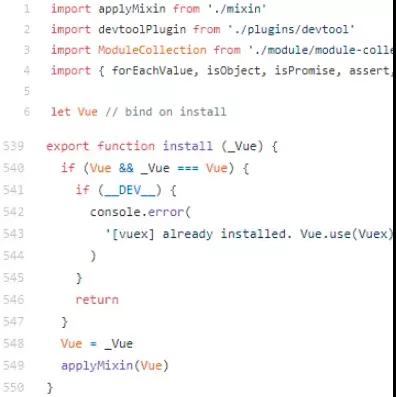面試官:說說你對單例模式的理解?如何實現(xiàn)?
本文轉(zhuǎn)載自微信公眾號「JS每日一題」,作者灰灰。轉(zhuǎn)載本文請聯(lián)系JS每日一題公眾號。
一、是什么
單例模式(Singleton Pattern):創(chuàng)建型模式,提供了一種創(chuàng)建對象的最佳方式,這種模式涉及到一個單一的類,該類負責(zé)創(chuàng)建自己的對象,同時確保只有單個對象被創(chuàng)建
在應(yīng)用程序運行期間,單例模式只會在全局作用域下創(chuàng)建一次實例對象,讓所有需要調(diào)用的地方都共享這一單例對象,如下圖所示:
從定義上來看,全局變量好像就是單例模式,但是一般情況我們不認(rèn)為全局變量是一個單例模式,原因是:
- 全局命名污染
- 不易維護,容易被重寫覆蓋
二、實現(xiàn)
在javascript中,實現(xiàn)一個單例模式可以用一個變量來標(biāo)志當(dāng)前的類已經(jīng)創(chuàng)建過對象,如果下次獲取當(dāng)前類的實例時,直接返回之前創(chuàng)建的對象即可,如下:
- // 定義一個類
- function Singleton(name) {
- this.name = name;
- this.instance = null;
- }
- // 原型擴展類的一個方法getName()
- Singleton.prototype.getName = function() {
- console.log(this.name)
- };
- // 獲取類的實例
- Singleton.getInstance = function(name) {
- if(!this.instance) {
- this.instance = new Singleton(name);
- }
- return this.instance
- };
- // 獲取對象1
- const a = Singleton.getInstance('a');
- // 獲取對象2
- const b = Singleton.getInstance('b');
- // 進行比較
- console.log(a === b);
使用閉包也能夠?qū)崿F(xiàn),如下:
- function Singleton(name) {
- this.name = name;
- }
- // 原型擴展類的一個方法getName()
- Singleton.prototype.getName = function() {
- console.log(this.name)
- };
- // 獲取類的實例
- Singleton.getInstance = (function() {
- var instance = null;
- return function(name) {
- if(!this.instance) {
- this.instance = new Singleton(name);
- }
- return this.instance
- }
- })();
- // 獲取對象1
- const a = Singleton.getInstance('a');
- // 獲取對象2
- const b = Singleton.getInstance('b');
- // 進行比較
- console.log(a === b);
也可以將上述的方法稍作修改,變成構(gòu)造函數(shù)的形式,如下:
- // 單例構(gòu)造函數(shù)
- function CreateSingleton (name) {
- this.name = name;
- this.getName();
- };
- // 獲取實例的名字
- CreateSingleton.prototype.getName = function() {
- console.log(this.name)
- };
- // 單例對象
- const Singleton = (function(){
- var instance;
- return function (name) {
- if(!instance) {
- instance = new CreateSingleton(name);
- }
- return instance;
- }
- })();
- // 創(chuàng)建實例對象1
- const a = new Singleton('a');
- // 創(chuàng)建實例對象2
- const b = new Singleton('b');
- console.log(a===b); // true
三、使用場景
在前端中,很多情況都是用到單例模式,例如頁面存在一個模態(tài)框的時候,只有用戶點擊的時候才會創(chuàng)建,而不是加載完成之后再創(chuàng)建彈窗和隱藏,并且保證彈窗全局只有一個
可以先創(chuàng)建一個通常的獲取對象的方法,如下:
- const getSingle = function( fn ){
- let result;
- return function(){
- return result || ( result = fn .apply(this, arguments ) );
- }
- };
創(chuàng)建彈窗的代碼如下:
- const createLoginLayer = function(){
- var div = document.createElement( 'div' );
- div.innerHTML = '我是浮窗';
- div.style.display = 'none';
- document.body.appendChild( div );
- return div;
- };
- const createSingleLoginLayer = getSingle( createLoginLayer );
- document.getElementById( 'loginBtn' ).onclick = function(){
- var loginLayer = createSingleLoginLayer();
- loginLayer.style.display = 'block';
- };
上述這種實現(xiàn)稱為惰性單例,意圖解決需要時才創(chuàng)建類實例對象
并且Vuex、redux全局態(tài)管理庫也應(yīng)用單例模式的思想,如下圖:
現(xiàn)在很多第三方庫都是單例模式,多次引用只會使用同一個對象,如jquery、lodash、moment...
參考文獻
https://zh.wikipedia.org/zh-hans/%E5%8D%95%E4%BE%8B%E6%A8%A1%E5%BC%8F
https://www.runoob.com/design-pattern/singleton-pattern.html
https://juejin.cn/post/6844903874210299912#heading-5






























